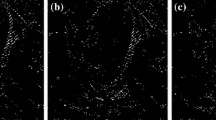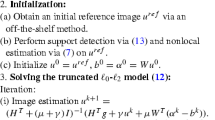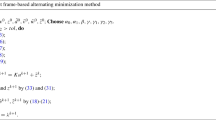Abstract
Wavelet frame based models for image restoration have been extensively studied for the past decade (Chan et al. in SIAM J. Sci. Comput. 24(4):1408–1432, 2003; Cai et al. in Multiscale Model. Simul. 8(2):337–369, 2009; Elad et al. in Appl. Comput. Harmon. Anal. 19(3):340–358, 2005; Starck et al. in IEEE Trans. Image Process. 14(10):1570–1582, 2005; Shen in Proceedings of the international congress of mathematicians, vol. 4, pp. 2834–2863, 2010; Dong and Shen in IAS lecture notes series, Summer program on “The mathematics of image processing”, Park City Mathematics Institute, 2010). The success of wavelet frames in image restoration is mainly due to their capability of sparsely approximating piecewise smooth functions like images. Most of the wavelet frame based models designed in the past are based on the penalization of the ℓ 1 norm of wavelet frame coefficients, which, under certain conditions, is the right choice, as supported by theories of compressed sensing (Candes et al. in Appl. Comput. Harmon. Anal., 2010; Candes et al. in IEEE Trans. Inf. Theory 52(2):489–509, 2006; Donoho in IEEE Trans. Inf. Theory 52:1289–1306, 2006). However, the assumptions of compressed sensing may not be satisfied in practice (e.g. for image deblurring and CT image reconstruction). Recently in Zhang et al. (UCLA CAM Report, vol. 11-32, 2011), the authors propose to penalize the ℓ 0 “norm” of the wavelet frame coefficients instead, and they have demonstrated significant improvements of their method over some commonly used ℓ 1 minimization models in terms of quality of the recovered images. In this paper, we propose a new algorithm, called the mean doubly augmented Lagrangian (MDAL) method, for ℓ 0 minimizations based on the classical doubly augmented Lagrangian (DAL) method (Rockafellar in Math. Oper. Res. 97–116, 1976). Our numerical experiments show that the proposed MDAL method is not only more efficient than the method proposed by Zhang et al. (UCLA CAM Report, vol. 11-32, 2011), but can also generate recovered images with even higher quality. This study reassures the feasibility of using the ℓ 0 “norm” for image restoration problems.











Similar content being viewed by others
References
Chan, R., Chan, T., Shen, L., Shen, Z.: Wavelet algorithms for high-resolution image reconstruction. SIAM J. Sci. Comput. 24(4), 1408–1432 (2003)
Cai, J., Osher, S., Shen, Z.: Split Bregman methods and frame based image restoration. Multiscale Model. Simul. 8(2), 337–369 (2009)
Elad, M., Starck, J., Querre, P., Donoho, D.: Simultaneous cartoon and texture image inpainting using morphological component analysis (MCA). Appl. Comput. Harmon. Anal. 19(3), 340–358 (2005)
Starck, J., Elad, M., Donoho, D.: Image decomposition via the combination of sparse representations and a variational approach. IEEE Trans. Image Process. 14(10), 1570–1582 (2005)
Shen, Z.: Wavelet frames and image restorations. In: Proceedings of the International Congress of Mathematicians, vol. 4, pp. 2834–2863 (2010)
Dong, B., Shen, Z.: MRA-based wavelet frames and applications. IAS Lecture Notes Series, Summer Program on “The Mathematics of Image Processing”. Park City Mathematics Institute (2010)
Candes, E., Eldar, Y., Needell, D., Randall, P.: Compressed sensing with coherent and redundant dictionaries. Appl. Comput. Harmon. Ann. (2010)
Candes, E., Romberg, J., Tao, T.: Robust uncertainty principles: exact signal reconstruction from highly incomplete frequency information. IEEE Trans. Inf. Theory 52(2), 489–509 (2006)
Donoho, D.: Compressed sensing. IEEE Trans. Inf. Theory 52, 1289–1306 (2006)
Zhang, Y., Dong, B., Lu, Z.: ℓ 0 minimization of wavelet frame based image restoration. UCLA CAM Report, vol. 11-32 (2011)
Rockafellar, R.: Augmented Lagrangians and applications of the proximal point algorithm in convex programming. Math. Oper. Res. 97–116 (1976)
Rudin, L., Osher, S., Fatemi, E.: Nonlinear total variation based noise removal algorithms. Physica D 60, 259–268 (1992)
Chambolle, A., Lions, P.: Image recovery via total variation minimization and related problems. Numer. Math. 76(2), 167–188 (1997)
Meyer, Y.: Oscillating Patterns in Image Processing and Nonlinear Evolution Equations: The Fifteenth Dean Jacqueline B. Lewis Memorial Lectures. AMS, Providence (2001)
Sapiro, G.: Geometric Partial Differential Equations and Image Analysis. Cambridge University Press, Cambridge (2001)
Osher, S., Fedkiw, R.: Level Set Methods and Dynamic Implicit Surfaces. Springer, Berlin (2003)
Chan, T., Esedoglu, S., Park, F., Yip, A.: Total variation image restoration: overview and recent developments. In: Handbook of Mathematical Models in Computer Vision, pp. 17–31 (2006)
Aubert, G., Kornprobst, P.: Mathematical Problems in Image Processing: Partial Differential Equations and the Calculus of Variations. Springer, Berlin (2006)
Chan, R., Shen, L., Shen, Z.: A framelet-based approach for image inpainting. Res. Rep. 4, 325 (2005)
Cai, J., Osher, S., Shen, Z.: Linearized Bregman iterations for frame-based image deblurring. SIAM J. Imaging Sci. 2(1), 226–252 (2009)
Cai, J., Dong, B., Osher, S., Shen, Z.: Image restorations: total variation, wavelet frames and beyond. J. Am. Math. Soc. (2012, accepted)
Ron, A., Shen, Z.: Affine systems in L 2(ℝd): the analysis of the analysis operator. J. Funct. Anal. 148(2), 408–447 (1997)
Daubechies, I.: Ten Lectures on Wavelets. CBMS-NSF Lecture Notes, vol. 61. SIAM, Philadelphia (1992)
Daubechies, I., Han, B., Ron, A., Shen, Z.: Framelets: Mra-based constructions of wavelet frames. Appl. Comput. Harmon. Anal. 14, 1–46 (2003)
Daubechies, I., Teschke, G., Vese, L.: Iteratively solving linear inverse problems under general convex constraints. Inverse Probl. Theor. Imaging 1(1), 29 (2007)
Fadili, M., Starck, J.: Sparse representations and Bayesian image inpainting. In: Proc. SPARS, vol. 5 (2005)
Fadili, M., Starck, J., Murtagh, F.: Inpainting and zooming using sparse representations. Comput. J. 52(1), 64 (2009)
Figueiredo, M., Nowak, R.: An EM algorithm for wavelet-based image restoration. IEEE Trans. Image Process. 12(8), 906–916 (2003)
Figueiredo, M., Nowak, R.: A bound optimization approach to wavelet-based image deconvolution. In: IEEE International Conference on Image Processing. ICIP 2005, vol. 2, p. II-782. IEEE, New York (2005)
Cai, J., Chan, R., Shen, L., Shen, Z.: Convergence analysis of tight framelet approach for missing data recovery. Adv. Comput. Math. 1–27 (2008)
Cai, J., Chan, R., Shen, Z.: Simultaneous cartoon and texture inpainting. In: Inverse Problems and Imaging (IPI), vol. 4, pp. 379–395 (2010)
Candes, E., Tao, T.: Near-optimal signal recovery from random projections: universal encoding strategies? IEEE Trans. Inf. Theory 52(12), 5406–5425 (2006)
Candes, E., Tao, T.: Decoding by linear programming. IEEE Trans. Inf. Theory 51(12), 4203–4215 (2005)
Lu, Z., Zhang, Y.: Penalty decomposition methods for l 0-norm minimization. Technical report, Department of Mathematics, Simon Fraser University, Canada (2010)
Chartrand, R.: Exact reconstructions of sparse signals via nonconvex minimization. IEEE Signal Process. Lett. 14, 707–710 (2007)
Chartrand, R., Yin, W.: Iteratively reweighted algorithms for compressive sensing. In: 33rd International Conference on Acoustics, Speech, and Signal Processing (ICASSP) (2008)
Chartrand, R.: Fast algorithms for nonconvex compressive sensing: MRI reconstruction from very few data. In: IEEE International Symposium on Biomedical Imaging (ISBI) (2009)
Hiriart-Urruty, J., Lemaréchal, C.: Convex Analysis and Minimization Algorithms: Fundamentals. Springer, Berlin (1993)
Goldstein, T., Osher, S.: The split Bregman algorithm for L1 regularized problems. SIAM J. Imaging Sci. 2(2), 323–343 (2009)
Zhang, X., Burger, M., Bresson, X., Osher, S.: Bregmanized nonlocal regularization for deconvolution and sparse reconstruction. SIAM J. Imaging Sci. 3, 253 (2010)
Gabay, D., Mercier, B.: A dual algorithm for the solution of nonlinear variational problems via finite element approximation. Comput. Math. Appl. 2(1), 17–40 (1976)
Bertsekas, D., Tsitsiklis, J.: Parallel and Distributed Computation: Numerical Methods. Prentice-Hall, New York (1989)
Eckstein, J., Bertsekas, D.: On the Douglas “Rachford splitting method and the proximal point algorithm for maximal monotone operators”. Math. Program. 55(1), 293–318 (1992)
Hestenes, M.: Multiplier and gradient methods. J. Optim. Theory Appl. 4(5), 303–320 (1969)
Powell, M.: A method for non-linear constraints in minimization problems. In: Fletcher, R. (ed.) Optimization, pp. 283–298. Academic Press, New York (1969)
Glowinski, R., Le Tallec, P.: Augmented Lagrangian and Operator-Splitting Methods in Nonlinear Mechanics. SIAM, Philadelphia (1989)
Esser, E.: Applications of Lagrangian-based alternating direction methods and connections to split Bregman. CAM Rep. 9, 31 (2009)
Tai, X., Wu, C.: Augmented Lagrangian method, dual methods and split Bregman iteration for ROF model. In: Scale Space and Variational Methods in Computer Vision, pp. 502–513 (2009)
Donoho, D.: De-noising by soft-thresholding. IEEE Trans. Inf. Theory 41, 613–627 (1995)
Mrázek, P., Weickert, J.: Rotationally invariant wavelet shrinkage. Pattern Recognit 156–163 (2003)
Iusem, A.: Augmented Lagrangian methods and proximal point methods for convex optimization. Investig. Oper. 8, 11–49 (1999)
Eckstein, J.: Nonlinear proximal point algorithms using Bregman functions, with applications to convex programming. Math. Oper. Res. 202–226 (1993)
Zhu, M., Chan, T.: An efficient primal-dual hybrid gradient algorithm for total variation image restoration. Mathematics Department, UCLA, CAM Report, pp. 08-34 (2007)
Ma, S., Yin, W., Zhang, Y., Chakraborty, A.: An efficient algorithm for compressed mr imaging using total variation and wavelets. In: IEEE Conference on Computer Vision and Pattern Recognition. CVPR 2008, pp. 1–8. IEEE, New York (2008)
Wang, Y., Yang, J., Yin, W., Zhang, Y.: A new alternating minimization algorithm for total variation image reconstruction. SIAM J. Imaging Sci. 1(3), 248–272 (2008)
Yang, J., Zhang, Y., Yin, W.: A fast tvl 1-l 2 minimization algorithm for signal reconstruction from partial Fourier data. IEEE J. Sel. Top. Signal Process. 4, 288–297 (2009)
Wang, Y., Yin, W.: Sparse signal reconstruction via iterative support detection. SIAM J. Imaging Sci. 3(3), 462–491 (2010)
Chen, Y., Hager, W., Huang, F., Phan, D., Ye, X., Yin, W.: Fast algorithms for image reconstruction with application to partially parallel MR imaging. SIAM J. Imaging Sci. 5(1), 90–118 (2010)
Cai, X., Gu, G., He, B., Yuan, X.: A relaxed customized proximal point algorithm for separable convex programming. Preprint (2011)
Antoniadis, A., Fan, J.: Regularization of wavelet approximations. J. Am. Stat. Assoc. 96(455), 939–967 (2001)
Donoho, D., Johnstone, I.: Threshold selection for wavelet shrinkage of noisy data. In: Engineering in Medicine and Biology Society, 1994. Engineering Advances: New Opportunities for Biomedical Engineers. Proceedings of the 16th Annual International Conference of the IEEE, pp. A24–A25. IEEE, New York (1994)
Larsson, T., Patriksson, M., Stromberg, A.: Ergodic convergence in subgradient optimization. Optim. Methods Softw. 9(1), 93–120 (1998)
Larsson, T., Patriksson, M., Strömberg, A.: Ergodic, primal convergence in dual subgradient schemes for convex programming. Math. Program. 86(2), 283–312 (1999)
Author information
Authors and Affiliations
Corresponding author
Rights and permissions
About this article
Cite this article
Dong, B., Zhang, Y. An Efficient Algorithm for ℓ 0 Minimization in Wavelet Frame Based Image Restoration. J Sci Comput 54, 350–368 (2013). https://doi.org/10.1007/s10915-012-9597-4
Received:
Revised:
Accepted:
Published:
Issue Date:
DOI: https://doi.org/10.1007/s10915-012-9597-4




